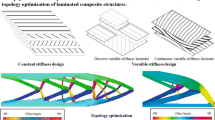Conclusions
The illustrative examples presented above show that the proposed optimum design method based on planning of experiments is an efficient method for the minimum weight design of sandwich and laminated composite plates. Vibration and damping constraints can be modeled using simple mathematical expressions. These expressions are obtained using the finite element solution in the experiment points. Reference points in the search domain are determined from plans of experiment. The advantage of the proposed method is its minimum computational effort for repeated finite element solutions. The major advantage of the method is the possibility of using the data not only from the computer solution, but also the data obtained experimentally in the reference points. In this case, simple mathematical models represent both theoretical and experimental data.
Similar content being viewed by others
References
P. Audze and V. Eglajs, “New approach for planning of experiments”, in: Problems of Dynamics and Strength, Vol. 35 [in Russian], Zinatne Publishing House, Riga (1977), pp. 104–107.
R. Rikards, A. K. Bledzki, V. Eglaja, A. Chate, and K. Kurek, “Elaboration of optimal design models for composite materials from data of experiments”, Mech. Composite Mater.,28, No. 3, 435–445 (1992).
R. Rikards, “Elaboration of optimal design models for objects from data of experiments”, in: Optimal Design with Advanced Materials, Proc. IUTAM Symp. Lungby, Denkar, Aug., 18–20, 1992, P. Pedersen (ed.), Elsevier Science Publishers (1993), pp. 148–162.
V. Eglajs, “Approximation of table data by multivariable equation of regression”, in: Problems of Dynamics and Strength, Vol. 39 [in Russian], Zinatne Publishing House, Riga (1981), pp. 120–125.
M. S. Bazarra and C. M. Shetty, Nonlinear Programming, Theory and Algorithms, Wiley, NY-Chichester-Brisbane-Toronto (1979).
V. Eglajs, “Intuitive search — an effective version of random search method”, in: Problems of Random Search, Vol. 11 [in Russian], Zinatne Publishing House, Riga (1988), pp. 53–62.
D. X. Lin, R. G. Ni, and R. G. Adams, “Prediction and measurement of vibrational damping parameters of carbon and glass fiber-reinforced plastic plates”, J. Composite Mater.,18, 132–152 (1984).
R. M. Crane and J. W. Gillespie Jr., “Analytical model for prediction of the damping loss factor of composite materials”, Polymer Composites,13, No. 3, 179–190 (1992).
Divinycell, Technical Specification. High Performance Core Material for Sandwich Construction, Barracuda Technologies AB Technical Report, Laholm, Sweden (1991).
R. B. Rikards, A. K. Chate, and A. V. Korjakin, “Damping analysis of laminated composite plates”, Mech. Composite Mater.,30, No. 1, 91–104 (1994).
R. Rikards, A. Chate, and E. Barkanov, “Finite element analysis of damping the vibrations of laminated composites”, Computers and Structures,47, No. 6, 1005–1015 (1993).
E. E. Ungar and E. M. Jerwin, “Loss factors of viscoelastic systems in terms of energy concepts”, J. Acoust. Soc. Amer.,34, No. 7, 954–958 (1962).
Y.-S. Lee, Y.-W. Lee, and M.-S. Na, “Optimal design of hybrid laminated composite plates”, Composites. Design, Manufacture and Application. Proc. 8th Intern. Conf. Composite Materials, Honolulu, July 15–19, 1991, Published by SAMPE (1991), 1-K-1–1-K-12.
Author information
Authors and Affiliations
Additional information
Published in Mekhanika Kompozitnykh Materialov, Vol. 31, No. 1, pp. 51–64, January–February, 1995.
Rights and permissions
About this article
Cite this article
Rikards, R. Minimum weight design of sandwich and laminated composite structures. Mech Compos Mater 31, 39–49 (1995). https://doi.org/10.1007/BF00616735
Received:
Issue Date:
DOI: https://doi.org/10.1007/BF00616735




